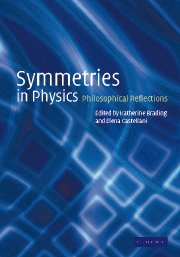Book contents
- Frontmatter
- Contents
- List of contributors
- Preface
- Copyright acknowledgements
- 1 Introduction
- Part I Continuous symmetries
- Part II Discrete symmetries
- 11 Classic texts: extracts from Leibniz, Kant, and Black
- 12 Understanding permutation symmetry
- 13 Quarticles and the identity of indiscernibles
- 14 Handedness, parity violation, and the reality of space
- 15 Mirror symmetry: what is it for a relational space to be orientable?
- 16 Physics and Leibniz's principles
- Part III Symmetry breaking
- Part IV General interpretative issues
- Index
15 - Mirror symmetry: what is it for a relational space to be orientable?
Published online by Cambridge University Press: 08 October 2009
- Frontmatter
- Contents
- List of contributors
- Preface
- Copyright acknowledgements
- 1 Introduction
- Part I Continuous symmetries
- Part II Discrete symmetries
- 11 Classic texts: extracts from Leibniz, Kant, and Black
- 12 Understanding permutation symmetry
- 13 Quarticles and the identity of indiscernibles
- 14 Handedness, parity violation, and the reality of space
- 15 Mirror symmetry: what is it for a relational space to be orientable?
- 16 Physics and Leibniz's principles
- Part III Symmetry breaking
- Part IV General interpretative issues
- Index
Summary
Introduction
I want to take issue with the definition of enantiomorphy that Pooley gives in his paper in this volume. His account goes something like this:
(a) Suppose that the relationist has an account of the dimensionality of space, according to which space is n-dimensional.
(b) The relations – especially the multiple relations – between the parts of a body determine whether it is geometrically embeddable in n-dimensional spaces that are either (only) orientable or (only) non-orientable.
(c) Then ‘an object is an enantiomorph iff, withrespect to every possible abstract [n]-dimensional embedding space, each reflective mapping of the object differs in its outcome from every rigid motion of it.’
This account depends on the truth of (b). Suppose that a body were embeddable in both orientable and non-orientable spaces of n dimensions. Then it might fail to be an enantiomorph, not because any of its possible reflections in physical space was identical to a rigid motion of the body, but because in some abstract space a reflection and a rigid motion of its image are identical. Pooley (in note 14) makes this point, but claims that the burden of proof falls on the opponent of his account to show that (b) is false.
- Type
- Chapter
- Information
- Symmetries in PhysicsPhilosophical Reflections, pp. 281 - 288Publisher: Cambridge University PressPrint publication year: 2003

